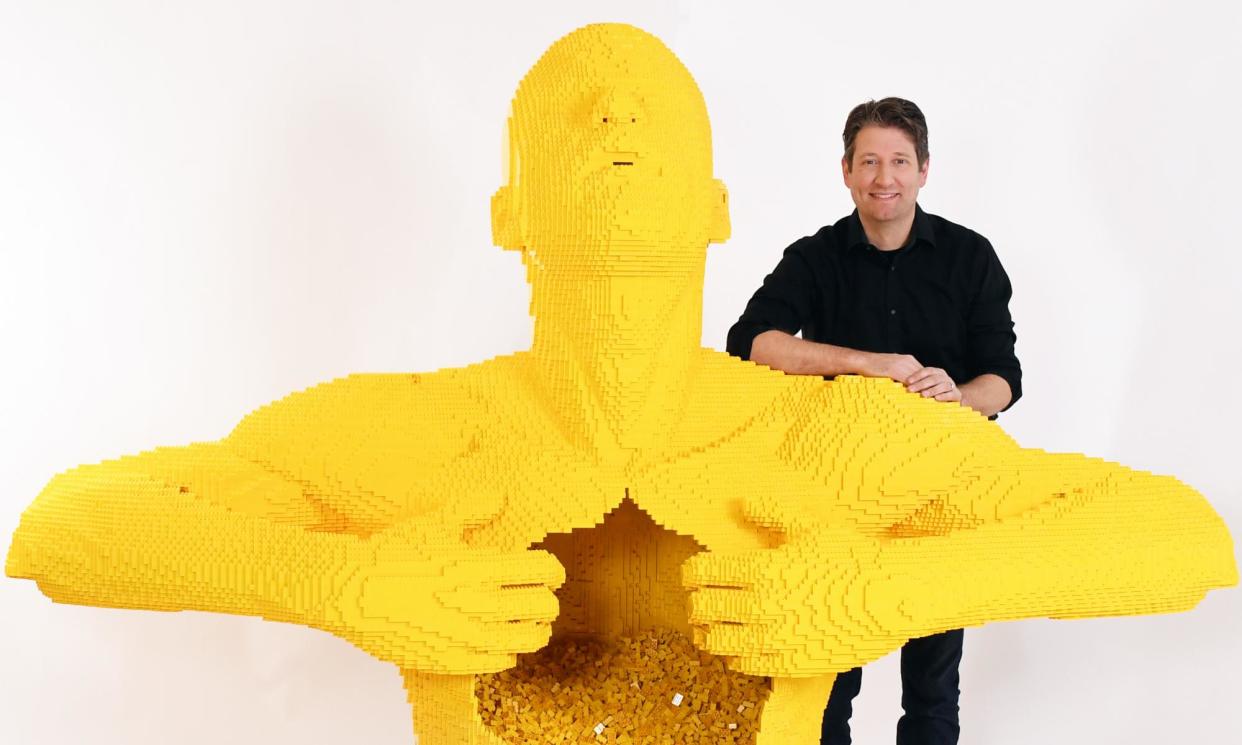The Wall Street lawyer who quit to make Lego art: ‘It is a job, not a hobby’

He’s made a living out of building sculptures from Lego and his work has been shown in 100 cities and 24 countries, attracting millions of visitors. But you won’t find any Lego in Nathan Sawaya’s home. Call it work-life balance: “I love what I do, but it is a job … not a hobby,” the 50-year-old American artist says.
It is a job, but it’s also something like a dream. Sawaya was a Wall Street lawyer who was unhappy with his career, playing with his favourite childhood toys after hours to unwind. Creating elaborate sculptures from scratch wasn’t unfamiliar to him – as a child, when his parents wouldn’t buy him a dog, he fashioned a lifesize pet from Lego bricks. “It was very rudimentary, but it was what I could do as a kid,” he recalls.
Sawaya began posting photos of his sculptures online. When his website crashed from all the clicks, he took it as a sign to quit law and pursue Lego. The first iteration of Sawaya’s travelling exhibition, the Art of the Brick, was held at a small art museum in Lancaster, Pennsylvania in 2007, featuring about two dozen sculptures. “I treated it like a wedding and invited all my friends and family from all over,” he says. “I expected that to be my last solo show, but fortunately it has kept going ever since.”
Initially, Sawaya was met with resistance from Lego – the company’s first ever contact was a cease and desist. But he eventually went to work for Lego as a master model builder (the people who build the models for Legoland and other official operations). The audition process sounds simple enough, but it requires skill. “They say: here’s a pile of bricks, build a sphere out of it. You build the sphere and they roll it across the table or the floor to see how you did.”
Related: Inside the Lego House – in pictures
After a short stint with Lego, Sawaya branched out on his own. He’s now a Lego certified professional, a title reserved for those who have made their own businesses from the bricks. “It’s a very good business relationship,” Sawaya says of his dealings with Lego these days. He has to buy the bricks, like anyone else. “I understand that they’re a toy company, and they understand that I’m an artist.”
Is there any tension in making art from a branded product? “Of course,” he says. “I’m subject to the decisions of a third party.” For example, he’s limited to the colours that Lego produces – he gets around this by having an extensive inventory of about 10m bricks between his two studios in Los Angeles and Las Vegas.
Sawaya doesn’t see his exhibition as promotional for Lego – “I don’t call the show the art of Lego,” he points out – but he acknowledges that the accessibility that makes him love the medium so much also equates to something of a monopoly. “It is still a brand, and that is a part of it,” he says. “When you get up very close to every sculpture of mine, you can see the word Lego on every individual piece.”
The Art of the Brick, which has just opened in Melbourne, has been a worldwide hit – there are three or four exhibitions running simultaneously at any given time. “They’re all different, but there are favourites that I’ve replicated because there’s some expectation that certain pieces are going to be there,” he says.
Sawaya’s most well-known piece is 2007’s Yellow, a sculpture of a man opening his own chest to reveal Lego pieces spilling out – Lady Gaga superimposed her head on to it in the video for her 2014 single G.U.Y. At the Melbourne show it looms large, surrounded by seven smaller-scale versions in different colours.
But there are plenty more. Sawaya doesn’t keep count of how many sculptures he’s created over the past two decades, but estimates that it might be close to a thousand. He’s made a six-metre-long Batmobile and a lifesize replica of Central Perk, the cafe from Friends, with fellow Lego artist Brandon Griffith, which required 1m bricks.
So what goes into planning a Lego sculpture on this level? “It depends on the piece, of course, but it all starts with the idea,” he says. “There’s some mapping that goes into it – sometimes it’s just drawing it out. Sometimes it’s digital.
“There’s also a lot of research that goes into it: am I doing a piece that people are familiar with? If it’s a replica – let’s say an art history piece – that’s going to require going and looking at the original, gathering photographs and whatnot. If it’s just pouring out of my brain, then it’s more trial and error.”
Related: Experience: I make prosthetic arms with Lego
In Melbourne, Sawaya’s works are animated with kinetics for the first time – 250 glowing skulls move in mesmerising waves against a mirrored wall, with lights and music adding a new dimension. In another room, there’s a lit-up recreation of Formula One driver Lando Norris’s helmet at an 18:1 ratio; in yet another, realistic animals, including a giraffe and a polar bear mother and cub, are projected against their natural habitats in a collaboration with the Australian photographer Dean West.
These creations are undeniably impressive, but peer into some corners of the internet and you’ll find some people asking: is it art? In Sawaya’s mind, at least, it doesn’t matter. “I leave it up to the art critics and students to decide what the art world thinks,” he says. “I’m not striving for it – I’m just doing my own thing.”
The Art of the Brick is on now at Melbourne Showgrounds.

 Yahoo News
Yahoo News 
